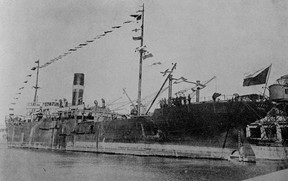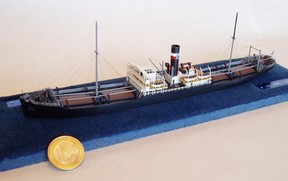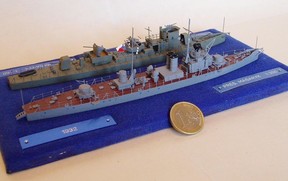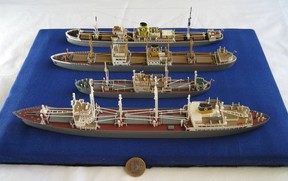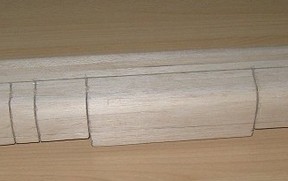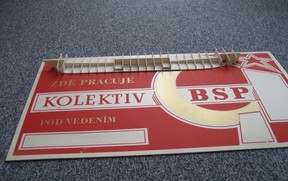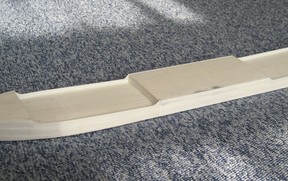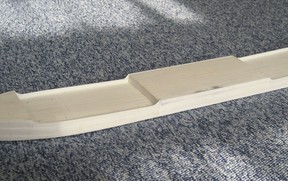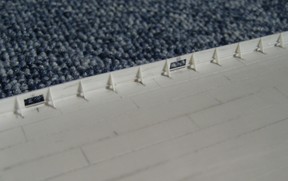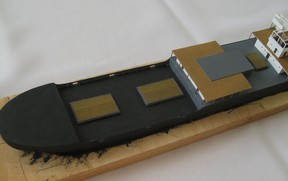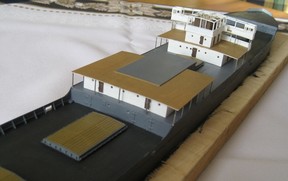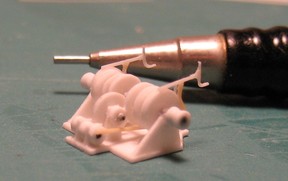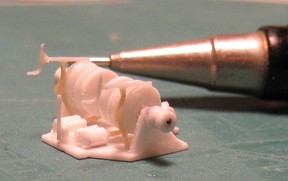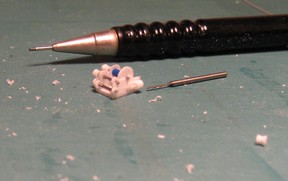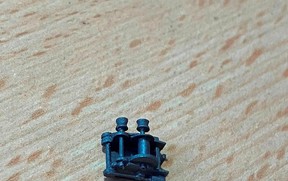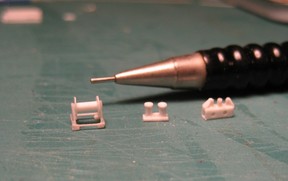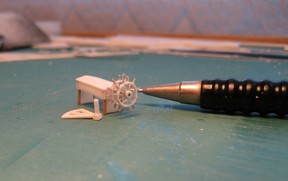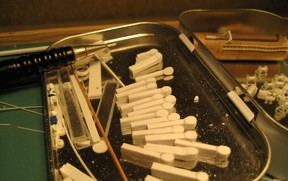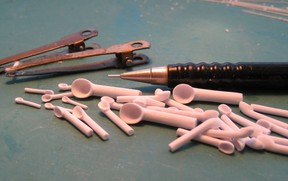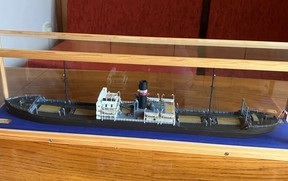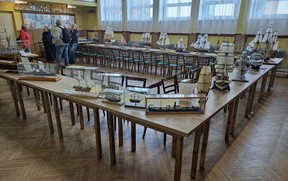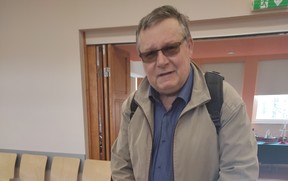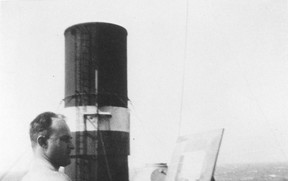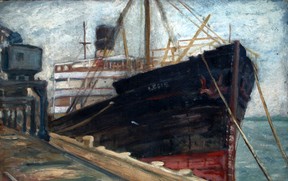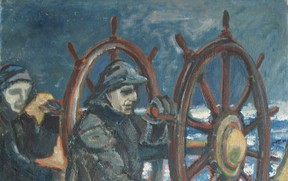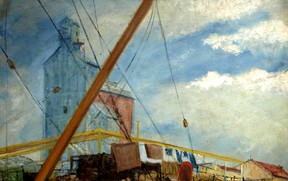Building S/S Legie (category C4)
The S/S Legie and me
Legie was the first steam-powered cargo ship (Steam ship S/S) to be operated under the Czechoslovak flag. It was between 1920 and 1933. I came into contact with Legie sometime in late 1977, when I came across a brand new book by Bedrich Stožický S palubou pod nohama (Publisher: Blok 1973) in an antique shop in Jihlava. I guess that's why, although new, it was in the antique shop. I knew about the Legion, of course, but I hadn't read anything further until then. An excellent buy! And then nothing for many years. I was into other kinds of "tabletop non-floating ship models" at the time.
The road to my Legion model started, without me knowing it, sometime in late 1988 when I got a damaged Russian plastic Potemkin 1:400 kit. I had to finish many of the parts. That actually made the difference. Several factors came together to build miniatures at that time - a three-room apartment + with two kids, the desire to travel to competitions in Jablonec with only small models, and the fact that the difference between a 500 and a 400 is not that big. So I gave it a try. I finished the first five hundred, the Polish ship Kraków from the plan in the Morze calendar, during the time of the canonization of Agnes of Bohemia and the November coup.
I started building Legion in a five-hundred as my fourth miniature. I didn't have much available in 1993. Photos of the model in the Technical Museum in Prague, Stožický's book, the "ABC technical atlas" with the Legie card, a photo and text in the 1929 book Cestami odboje, and photos from the 1932 Encyclopedia of Czechoslovak Youth. I drew the plan in pencil just to scale, because "what little I draw, I will be able to do". The plan is dated 1994. It had its competition debut in 1995 at the European Championships in Romania (fig. 1).
After finishing the Legie, I decided to continue building boats under our flag. President Masaryk / Bechelaren 1:250 and in the five hundredth Czechoslovakian naval cruise - Republic, Lidice, Pionýr, Orava. It was fun to go to competitions with such small models! (fig. 2 and 3)
I was living my modelling life happily, building things just for myself, so called out of competition, I was involved in the functionary work in the Association, until one beautiful day in 2010 I got a call from Mr. Marek Přikryl. Maybe you know - Mare-Czech publishing house. I had already provided him with my plans of the Republic and Lidice for Captain Antonín Fojtů's books of memories a few years before, and then some plans for a book on steam Austrian Lloyds by Mr. Miroslav Hubert.
He asked me if I would make a plan for his forthcoming book on the Legion from the photographs he would provide. In short, I gave in. There were a lot of photographs. Beautiful and interesting. Printed, sorted from stern to bow, sorted by angle of view, divided into thematic units. To have those pictures in my head. I conceived the plan, with the forthcoming book in mind, as intertwined with the photographs.
So - essential dimensions, proportions, equipment size, and so on, still away. Like the width of the cargo holds - I measured them by the width of the boatman's ass sitting there. Or such an interesting thing about the steps - some of them were not made of sheet metal, but of three iron rods. And what about the stern wheel - Stožický mentions a triple wheel, but in the photos with him it is double. Have you ever measured the 11 spokes of that wheel? Probably some local specialty! Or the rudder chain routing - you wouldn't believe how little information there is on that. Except in the British ocean tramps book, vol1, pretty clear. Height of superstructures, width of doors, etc, etc, all more or less according to available drawings and experience. I've drawn a lot of things 1:50 or even 1:25, it's mainly details. The basis was in "100". And when I had a plan, I also built a model. 1:250. Compared to the Legion in five hundred, it grew to quite a big ship. It's a big miniature. Whereas in the 500 you can simplify a lot of things, in the 200 you have to do everything in a lot of detail. I've spent three years working on all this. Even though I build boats on a waterline, here I had to make ribbing of the whole hull (fig. 4 and 5). By the way, the balsa cost quite a lot back then. During my very first miniature in 1989 I made the experience that the best wood is plastic and I still stick to that for miniatures. So the base of the Legion, because of its size, became a plate with the inscription Brigade of Socialist Labor. As you can see, it did not come into my use until many years after the Velvet Revolution. Waterline, keel and reinforcement for the screws between the ribs (fig. 6).
The plastic behaves in an interesting way - ships of "1s1" or "1bsi1" design (according to the German submarine sailors' manual of 1940), or with the engine room and superstructure only in the middle, i.e. those quite classic cargo steamers, behave when built on the waterline in such a way that they gradually swing upwards in the middle, while ships with a higher keel along the whole length tend to rise at the bow and stern. The fitting to the fixed pad must be adjusted accordingly.
For the hull I had to plastically plating the hull with 0.2 mm strips, the hull was plated one strip outwards, the other inwards, while the deck was plated from the centre in a roof-like manner (figs 7 and 8). The superstructures were not a problem at this size, only all the windows had to be glassed in, for which I used clear polystyrene from CD cases (figs 9 and 10).
That was actually the end of the "easier" part of the job. The steam winches are a chapter in themselves. At this scale you have to do everything the way it actually worked - gears, ratios, brakes, but also the actual steam engine drive. I haven't ventured into gearing at this scale though, after all, divide the usual tooth height by 250 and not much of it remains. Although it doesn't look like it, the anchor windlass gave relatively little work (figs. 11 and 12). It was worse with the winches at the masts. For one thing, there were plenty of them, and for another, they were smaller. Of course, everything had to match the functionality again. I think one of the winches is made of 36 parts (figs. 13 and 14).
The various other winches and mooring elements were not to be cheated and also consisted of multiple parts (fig. 16). Calculating the 11 spokes of the double rudder wheel in this scale to make it look symmetrical was also quite a chore (fig. 17).
A chapter in itself - some people write Ship ventilators, some people write deflectors, the Poles have a very precise term nawiewniky. Some of them are set up upwind and some downwind to make the ventilation of the inside of the boat perfect. Steamboat ventilators are quite a feat, especially when there are a lot of them. Well, the Legion didn't have a few of them, of various sizes (fig. 18). I'm "sculpting" them. First, I glue together squares of millimetre plastic, let them sit for a few days and then roughly cut them out and then sculpt them cleanly.
The aging is important. I glue all the plastic parts with an adhesive made from toluene with dissolved plastic scraps (fig. 19). In the course of maybe three days, the plastic soaks through the glue, the material is homogeneous, it's firm but not hard, and it's nice to sculpt. It can be carved and sanded. Sculptures from the largest to the smallest. The smallest one I managed to make years ago was 1.2 mm thick. All nice in the fingers. I can see well. Well, then you put it all together and it's a six-foot showcase with a boat (fig. 20).
But that is not the end of the Legion's story. I finished the boat in 2014, when I left the National Model Association after 43 years of membership, due to conceptual disagreements with the then leadership. Because championships are always "only for", Legion stayed years at "home". In 2020 I became a member of the Jablonec "Admiral", which in the third generation has already merits for the development of ship modelling in our country (meant very seriously). In 2021 it was " covided ", so its first public appearance took place after 7 years in 2021 in Borovany. I was looking forward to show a unique, reconstructed model, to show photos, because nobody had dealt with it in such detail in our country so far.... the result was disillusionment with the approach to the matter. I realized that the 6 years without competitions were not bad at all. When you go to competitions, you can tell yourself a thousand times that you are building for yourself, but subconsciously you always choose a model not only for yourself, but also for the competition, so that you don't "embarrass" yourself when you know your limits.
I, even as an international judge, used to say - even the "weakest" model is good, because how many people can do that!? It is wrong to just criticize, one must encourage! Any model is better than no model! Therefore, dear, you who build models, build them really for your own pleasure and don't pay much attention to the judges. You look at the model at home, you enjoy it. If you take a few points more or less from the contest, it won't make the bread cheaper. It's all about meeting people equally affected by a beautiful hobby!
From Hodonín
Ing. Vladislav Janoušek
The model will be on display "in natura"
at the 2023 World Championships in Jablonec.
Naval Captain Jan Hakl
The name of her captain, Jan Hakl (1895-1973), is also associated with the S/S LEGIE. He graduated from the Naval School of the C.C. Marina in Pula and then served on warships during the Austro-Hungarian Empire. In 1921 he joined to the Czechoslovak ship S/S Legie, where he served as commander until its sale to a Greek shipowner in 1930. He also studied painting at the Academy of Fine Arts as a student of Prof. Karel Holan. Painting followed him on all his live. Hence the S/S Legie became a frequent subject of his artwork.
